The Intel Core i9-7980XE and Core i9-7960X CPU Review Part 1: Workstation
by Ian Cutress on September 25, 2017 3:01 AM ESTBenchmarking Performance: CPU Legacy Tests
Our legacy tests represent benchmarks that were once at the height of their time. Some of these are industry standard synthetics, and we have data going back over 10 years. All of the data here has been rerun on Windows 10, and we plan to go back several generations of components to see how performance has evolved.
All of our benchmark results can also be found in our benchmark engine, Bench.
3D Particle Movement v1
3DPM is a self-penned benchmark, taking basic 3D movement algorithms used in Brownian Motion simulations and testing them for speed. High floating point performance, MHz and IPC wins in the single thread version, whereas the multithread version has to handle the threads and loves more cores. This is the original version, written in the style of a typical non-computer science student coding up an algorithm for their theoretical problem, and comes without any non-obvious optimizations not already performed by the compiler, such as false sharing.


CineBench 11.5 and 10
Cinebench is a widely known benchmarking tool for measuring performance relative to MAXON's animation software Cinema 4D. Cinebench has been optimized over a decade and focuses on purely CPU horsepower, meaning if there is a discrepancy in pure throughput characteristics, Cinebench is likely to show that discrepancy. Arguably other software doesn't make use of all the tools available, so the real world relevance might purely be academic, but given our large database of data for Cinebench it seems difficult to ignore a small five minute test. We run the modern version 15 in this test, as well as the older 11.5 and 10 due to our back data.
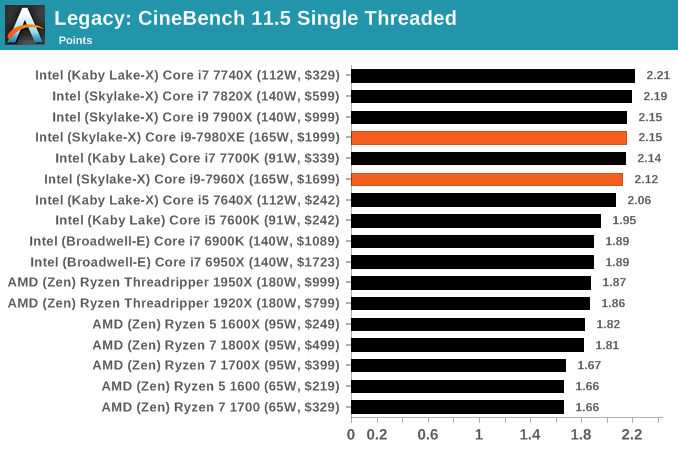
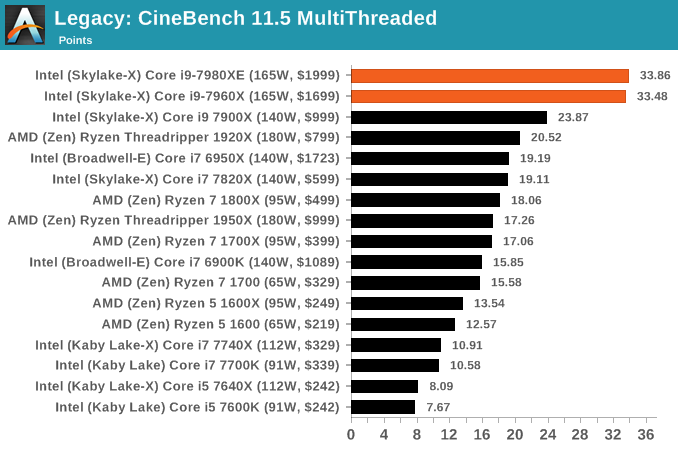
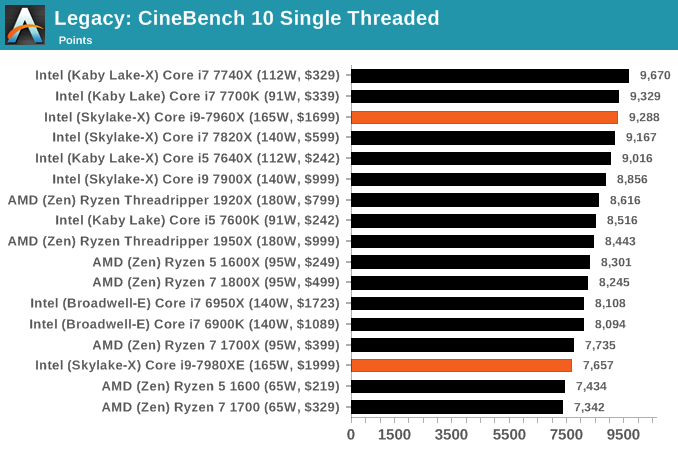
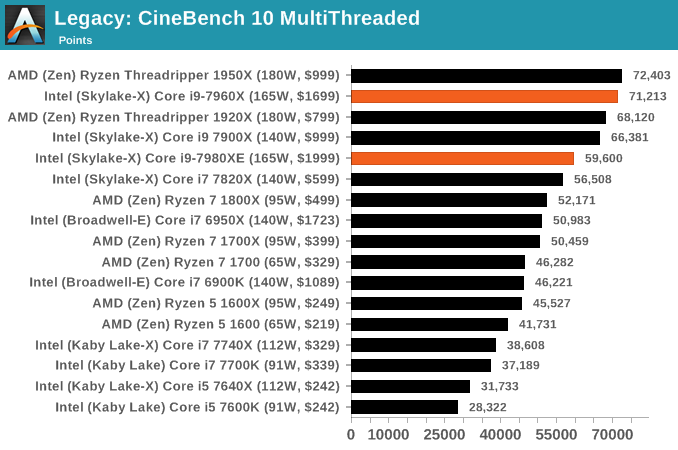
x264 HD 3.0
Similarly, the x264 HD 3.0 package we use here is also kept for historic regressional data. The latest version is 5.0.1, and encodes a 1080p video clip into a high quality x264 file. Version 3.0 only performs the same test on a 720p file, and in most circumstances the software performance hits its limit on high end processors, but still works well for mainstream and low-end. Also, this version only takes a few minutes, whereas the latest can take over 90 minutes to run.
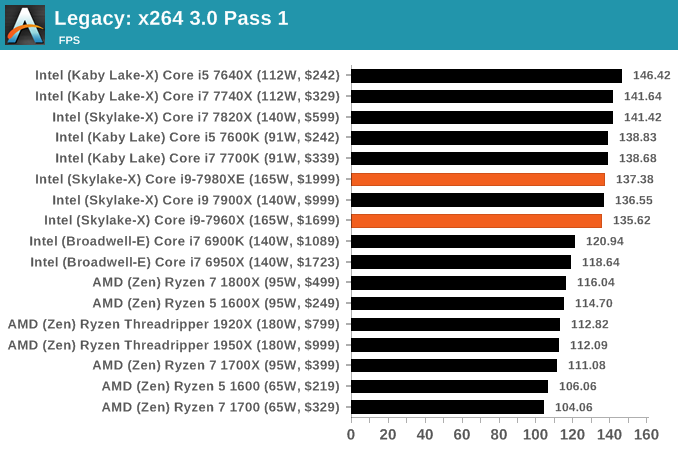
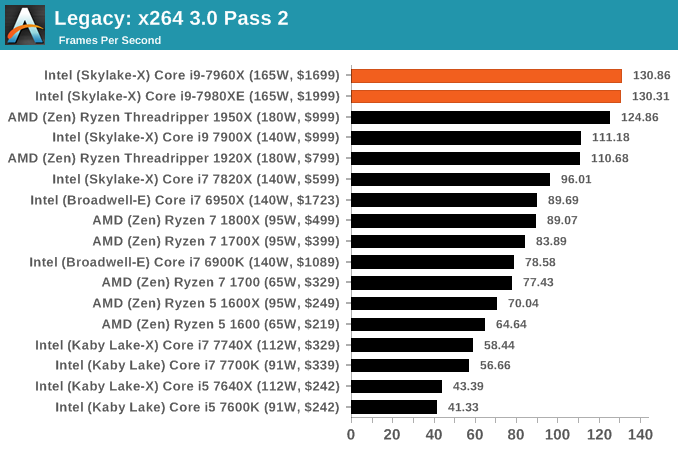










152 Comments
View All Comments
mapesdhs - Tuesday, September 26, 2017 - link
In that case, using Intel's MO, TR would have 68. What Intel is doing here is very misleading.iwod - Monday, September 25, 2017 - link
If we factor in the price of the whole system, rather then just CPU, ( AMD's MB tends to be cheaper ), then AMD is doing pretty well here. I am looking forward to next years 12nm Zen+.peevee - Monday, September 25, 2017 - link
From the whole line, only 7820X makes sense from price/performance standpoint.boogerlad - Monday, September 25, 2017 - link
Can an IPC comparison be done between this and Skylake-s? Skylake-x LCC lost in some cases to skylake, but is it due to lack of l3 cache or is it because the l3 cache is slower?IGTrading - Monday, September 25, 2017 - link
There will never be an IPC comparison of Intel's new processors, because all it would do is showcase how Intel's IPC actually went down from Broadwell and further down from KabyLake.Intel's IPC is a downtrend affair and this is not really good for click and internet traffic.
Even worse : it would probably upset Intel's PR and that website will surely not be receiving any early review samples.
rocky12345 - Monday, September 25, 2017 - link
Great review thank you. This is how a proper review is done. Those benchmarks we seen of the 18 core i9 last week were a complete joke since the guy had the chip over clocked to 4.2GHz on all core which really inflated the scores vs a stock Threadripper 16/32 CPU. Which was very unrealistic from a cooling stand point for the end users.This review had stock for stock and we got to see how both CPU camps performed out of the box states. I was a bit surprised the mighty 18 core CPU did not win more of the benches and when it did it was not by very much most of the time. So a 1K CPU vs a 2K CPU and the mighty 18 core did not perform like it was worth 1K more than the AMD 1950x or the 1920x for that matter. Yes the mighty i9 was a bit faster but not $1000 more faster that is for sure.
Notmyusualid - Thursday, September 28, 2017 - link
I too am interested to see 'out of the box performance' also.But if you think ANYONE would buy this and not overclock - you'd have to be out of your mind.
There are people out there running 4.5GHz on all cores, if you look for it.
And what is with all this 'unrealistic cooling' I keep hearing about? You fit the cooling that fits your CPU. My 14C/28T CPU runs 162W 24/7 running BOINC, and is attached to a 480mm 4-fan all copper radiator, and hand on my heart, I don't think has ever exceeded 42C, and sits at 38C mostly.
If I had this 7980XE, all I'd have to do is increase pump speed I expect.
wiyosaya - Monday, September 25, 2017 - link
Personally, I think the comments about people that spend $10K on licenses having the money to go for the $2K part are not necessarily correct. Companies will spend that much on a license because they really do not have any other options. The high end Intel part in some benchmarks gets 30 to may be 50 percent more performance on a select few benchmarks. I am not going to debate that that kind of performance improvement is significant even though it is limited to a few benchmarks; however, to me that kind of increased performance comes at an extreme price premium, and companies that do their research on the capabilities of each platform vs price are not, IMO, likely to throw away money on a part just for bragging rights. IMO, a better place to spend that extra money would be on RAM.HStewart - Monday, September 25, 2017 - link
In my last job, they spent over $100k for software version system.In workstation/server world they are looking for reliability, this typically means Xeon.
Gaming computers are different, usually kids want them and have less money, also they are always need to latest and greatest and not caring about reliability - new Graphics card comes out they replace it. AMD is focusing on that market - which includes Xbox One and PS 4
For me I looking for something I depend on it and know it will be around for a while. Not something that slap multiple dies together to claim their bragging rights for more core.
Competition is good, because it keeps Intel on it feat, I think if AMD did not purchase ATI they would be no competition for Intel at all in x86 market. But it not smart also - would anybody be serious about placing AMD Graphics Card on Intel CPU.
wolfemane - Tuesday, September 26, 2017 - link
Hate to burst your foreign bubble but companies are cheap in terms of staying within budgets. Specially up and coming corporations. I'll use the company I work for as an example. Fairly large print shop with 5 locations along the US West coast that's been in existence since the early 70's. About 400 employees in total. Server, pcs, and general hardware only sees an upgrade cycle once every 8 years (not all at once, it's spread out). Computer hardware is a big deal in this industry, and the head of IT for my company Has done pretty well with this kind of hardware life cycle. First off, macs rule here for preprocessing, we will never see a Windows based pc for anything more than accessing the Internet . But when it comes to our servers, it's running some very old xeons.As soon as the new fiscal year starts, we are moving to an epyc based server farm. They've already set up and established their offsite client side servers with epyc servers and IT absolutely loves them.
But why did I bring up macs? The company has a set budget for IT and this and the next fiscal year had budget for company wide upgrades. By saving money on the back end we were able to purchase top end graphic stations for all 5 locations (something like 30 new machines). Something they wouldn't have been able to do to get the same layout with Intel. We are very much looking forward to our new servers next year.
I'd say AMD is doing more than keeping Intel on their feet, Intel got a swift kick in the a$$ this year and are scrambling.